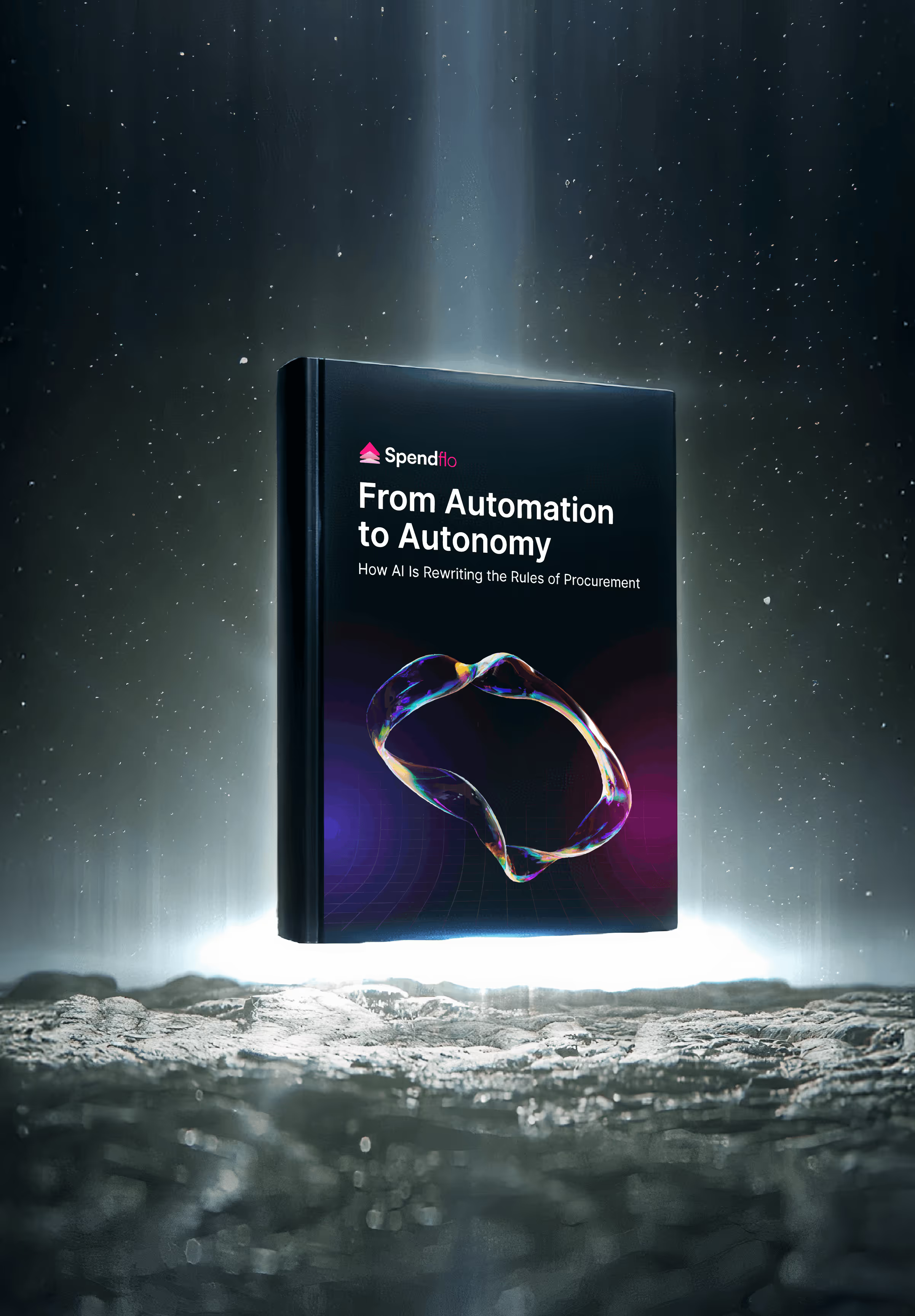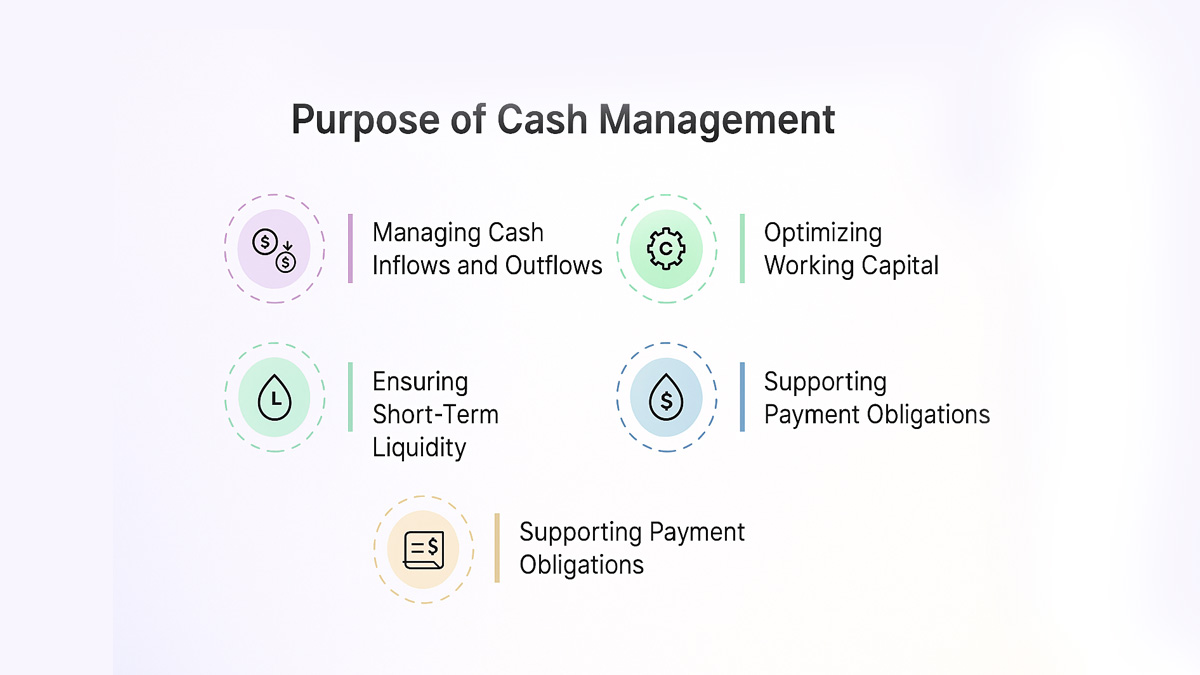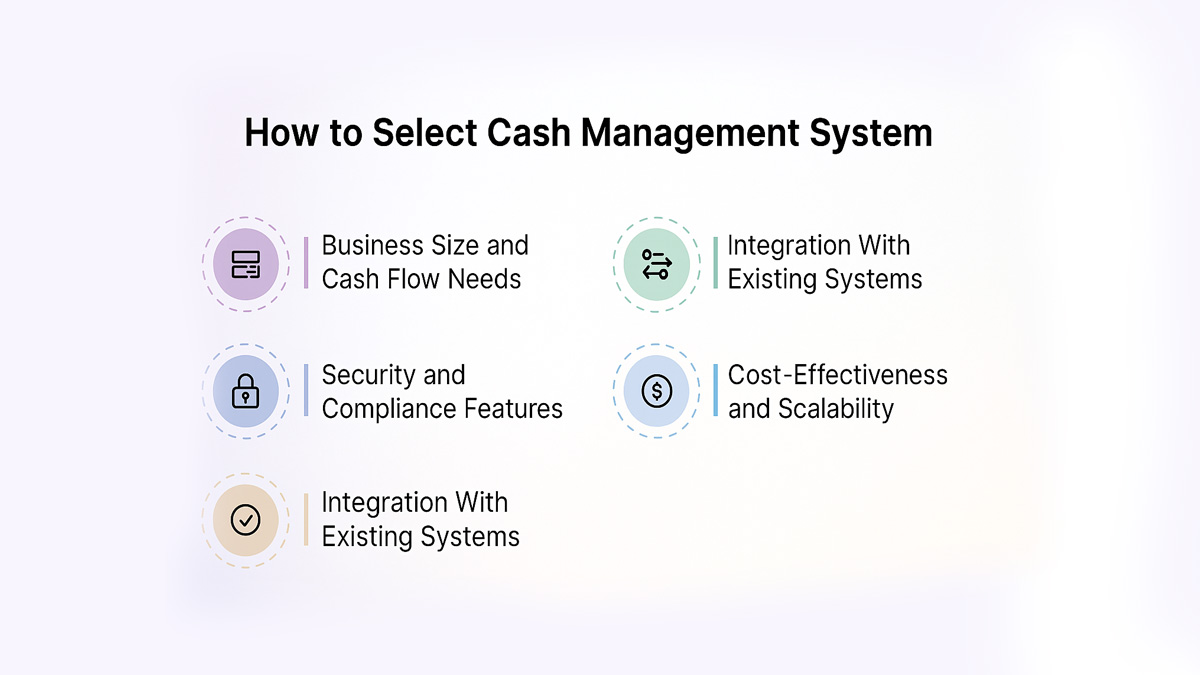

Cash Management: A Quick Guide (+Services & Solutions Included)

Cash Management: A Quick Guide (+Services & Solutions Included)
Learn how cash management improves liquidity, reduces risks, and supports business growth through effective strategies and modern tools.


In today’s fast-moving business environment, cash is more than just money in the bank - it's the fuel that keeps operations running, teams paid, and growth on track. Whether you're a startup managing runway or an enterprise with complex financial needs, mastering cash management is essential for financial resilience and profitability.
This guide explores what cash management is, why it’s vital for business health, the key functions involved, the evolving role of technology, how to select the right solution, and how Spendflo helps finance teams optimize cash through spend visibility and control.
What is Cash Management?
Cash management is the process of tracking, analyzing, and optimizing a business’s cash inflows and outflows to ensure liquidity, meet short-term obligations, and support long-term financial goals. It includes functions like forecasting, budgeting, collections, disbursements, and maintaining cash reserves.
Good cash management gives you control over your financial health - helping you make smarter decisions about payments, investments, and risk.
Why Cash Management Is Essential for Business Stability?
Effective cash management is the backbone of financial stability. It ensures that businesses can cover day-to-day expenses, handle unexpected costs, and plan for future growth without running into liquidity problems. Well-managed payments to suppliers can improve vendor relationships and even unlock early payment discounts.
Here’s why managing cash effectively is crucial:
1. Maintains Liquidity
Cash management helps ensure your business always has enough available funds to meet short-term obligations like payroll, rent, taxes, and vendor payments. Maintaining the right level of liquidity also prevents reliance on short-term loans. However, having access to lines of credit can provide a buffer during unexpected cash shortfalls.
2. Supports Strategic Financial Planning
Clear visibility into cash flow empowers finance teams to plan for capital investments, seasonal slowdowns, or expansion opportunities. It also helps plan funding strategies for acquiring long-term assets like equipment or infrastructure. Cash flow forecasting aligns spending with strategic business goals. Forecasts can also be adjusted based on changing market conditions, such as inflation or interest rate hikes.
3. Reduces Operational Risks
Poor cash management can lead to missed payments, overdrafts, and strained supplier relationships. Timely and accurate cash oversight minimizes risks, improves vendor trust, and prevents disruptions.
4. Enables Better Decision-Making
With up-to-date insight into available cash and upcoming expenses, finance leaders can make informed decisions on cost-cutting, new hires, acquisitions, and debt management.
Key Functions and Goals of Cash Management
Cash management encompasses several interconnected activities, all designed to improve a company’s financial agility and ensure long-term viability.

1. Managing Cash Inflows and Outflows
The most fundamental goal is to balance the money coming in (from sales, funding, etc.) with the money going out (payroll, rent, expenses). Businesses use rolling forecasts to plan daily, weekly, and monthly liquidity.
2. Optimizing Working Capital
Working capital - current assets minus current liabilities - is a key measure of financial health. Optimizing it involves speeding up receivables, slowing down payables (within reason), and keeping inventory lean.
3. Ensuring Short-Term Liquidity
Cash management ensures enough funds are available to cover short-term needs without tying up too much cash in idle accounts. Businesses may also invest surplus liquidity in low-risk vehicles like money market funds to earn returns while preserving access. Late payments from customers can severely disrupt liquidity if not tracked and managed proactively. This requires close monitoring of bank balances and expected cash movements.
4. Supporting Payment Obligations
Cash managers are responsible for ensuring timely payment of bills, salaries, and taxes while also capturing early payment discounts or avoiding late fees. Automation plays a big role here.
What is in a Cash Flow Statement?
A cash flow statement is a financial report that tracks how much cash enters and leaves a business over a specific period. It helps companies identify funding gaps, manage idle cash, and make informed decisions about financing options or investments. The statement is divided into three core sections:
1. Operating Activities
Covers the cash generated from day-to-day operations:
- Cash received from customers
- Payments to suppliers and employees
- Interest paid or earned
- Taxes and routine expenses
This section reveals whether your business can sustain operations without external funding.
2. Investing Activities
Includes transactions related to long-term assets:
- Purchases or sales of equipment
- Investment in or divestment from securities
- Loans given or repaid
Spending in this section often signals growth, while inflows can help cover short-term liquidity needs.
3. Financing Activities
Focuses on how the business raises or returns capital:
- Issuing equity or debt
- Repaying loans or lines of credit
- Paying dividends
Analyzing these sections helps finance teams optimize cash management practices, spot inefficient use of surplus cash, and adapt to changing market conditions.
Types of Cash Management Solutions for Businesses
Depending on size and complexity, businesses may use a mix of tools and services to manage their cash.
1. Bank-Based Cash Management Services
Most banks offer cash management services that include account reconciliation, wire transfers, lockbox services, automated clearing house (ACH) processing, and zero-balance accounts (ZBAs) to pool funds.
2. Treasury Management Systems (TMS)
TMS platforms are used by mid-to-large businesses to centralize cash forecasting, payment workflows, liquidity planning, and debt management. They integrate with ERPs and banks to offer real-time control.
3. Cash Flow Forecasting Tools
Modern forecasting tools help predict short-term and long-term cash positions based on historical data, upcoming receivables/payables, and budget inputs. AI-powered forecasting tools are becoming more common.
4. Accounts Receivable and Payable Solutions
AR/AP automation platforms help speed up collections, streamline invoicing, and schedule payments to optimize cash position. Features include invoice matching, approval workflows, and dynamic discounting.
How Technology Is Changing Business Cash Management
Technology has transformed cash management from a reactive function into a proactive, data-driven process that supports strategic decisions.
1. Real-Time Cash Visibility Platforms
Legacy spreadsheets can’t keep up with the speed of modern business. Today’s platforms offer real-time dashboards that display current balances, forecasts, and cash burn - so CFOs can act fast.
2. AI and Predictive Analytics for Forecasting
AI-powered tools can identify cash flow trends, flag risks, and forecast future positions with high accuracy. These tools also help businesses understand cash flow patterns across different departments or time periods. Predictive analytics also help spot anomalies, such as missing payments or overbilling.
3. Automated Payment Processing
Payment automation reduces manual work, prevents delays, and ensures adherence to payment terms. Integrated systems can trigger approvals, initiate payments, and sync records with accounting systems. Many businesses also rely on cloud-based payment platforms to automate disbursements and reduce manual processing errors.
4. Finance Automation Tools
Automation platforms like Spendflo integrate vendor management, budgeting, renewals, and approval workflows - improving visibility and reducing cash leakage from unnecessary or late SaaS payments.
Choosing the Right Cash Management System or Account
Every business has unique cash needs. Choosing the right solution means aligning functionality with business size, complexity, and growth stage.

1. Business Size and Cash Flow Needs
Smaller businesses may get by with a strong AP/AR automation tool, while enterprises often need full treasury management systems. Assess whether your challenge is forecasting, payments, or cash pooling. Reviewing historical cash flow statements can also highlight inefficiencies and help set realistic financial goals.
2. Integration With Existing Systems
The best solutions integrate with your existing ERP, CRM, and accounting tools. Look for real-time sync with bank accounts, billing software, and procurement platforms.
3. Security and Compliance Features
Ensure the system meets security standards like SOC 2 or ISO certifications. You’ll also need audit logs, role-based access, and compliance with local tax/payment regulations.
4. Cost-Effectiveness and Scalability
Choose a tool that fits your budget today but can scale as your transaction volumes or geographic footprint grows. Cloud-based platforms offer flexibility and lower upfront costs.
How Spendflo Helps With Cash Management
Spendflo empowers finance and procurement teams with real-time spend visibility, contract tracking, and proactive renewal management. Here's how it supports better cash management:
- Improved Financial Visibility: Get a complete view of your SaaS stack, upcoming renewals, and payment terms - all in one dashboard.
- Streamlined Procurement: Reduce purchase delays and enforce approval workflows to align spending with cash forecasts.
- Forecasting and Budgeting: Spendflo’s insights help teams anticipate spend spikes and avoid overpaying for unused or redundant tools.
- Optimized Cash Flow: Eliminate surprise renewals, automate contract tracking, and negotiate better terms to preserve liquidity.
Strong cash management isn't just about surviving the month - it’s about setting your business up for long-term success. From automating payables to forecasting accurately and gaining real-time financial visibility, today's tools give finance teams the edge they need.
And with Spendflo in your corner, you don’t just manage spend - you optimize it. Book a demo and we’ll show you how to lower costs, reduce risk, and move quicker without burning out your team.
Frequently Asked Questions on Cash Management
What are the key benefits of cash management?
It improves liquidity, reduces the need for borrowing, supports timely payments, helps you plan investments, and reduces the risk of insolvency. Good cash management also enables better vendor relationships.
How can businesses automate cash management?
By using tools like TMS, AP/AR automation software, spend management platforms like Spendflo, and AI forecasting tools. Automation reduces manual work and errors while speeding up processes.
What are the challenges in managing cash flow?
Challenges include unpredictable customer payments, overspending, limited financial visibility, seasonal income changes, and fragmented systems that don’t talk to each other.
How often should businesses review their cash management strategy?
At minimum, monthly. But growing or cash-strapped businesses should monitor and forecast cash daily or weekly to avoid surprises.
What is the difference between cash management and treasury management?
Cash management focuses on day-to-day liquidity - tracking inflows/outflows and making payments. Treasury management includes broader activities like investment planning, debt management, and risk mitigation.
What are the best cash management practices for using idle cash and choosing financing options?
Strong cash management practices involve putting idle cash to work through short-term investments or operational needs. Rather than letting it sit unused, businesses can explore financing options like credit lines or short-term loans to balance liquidity and growth.










.png)




.png)










.avif)





